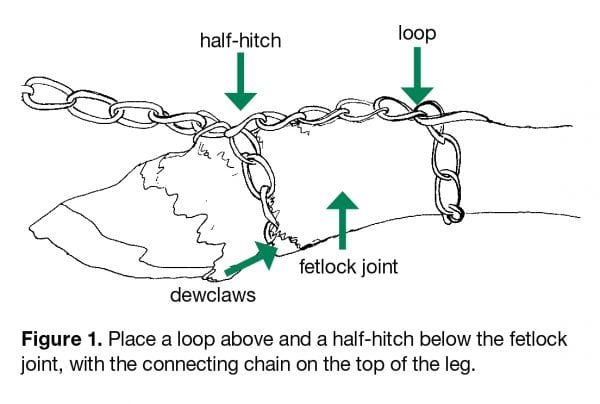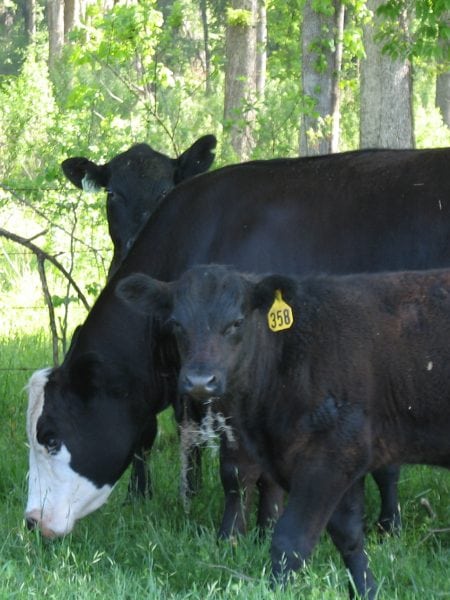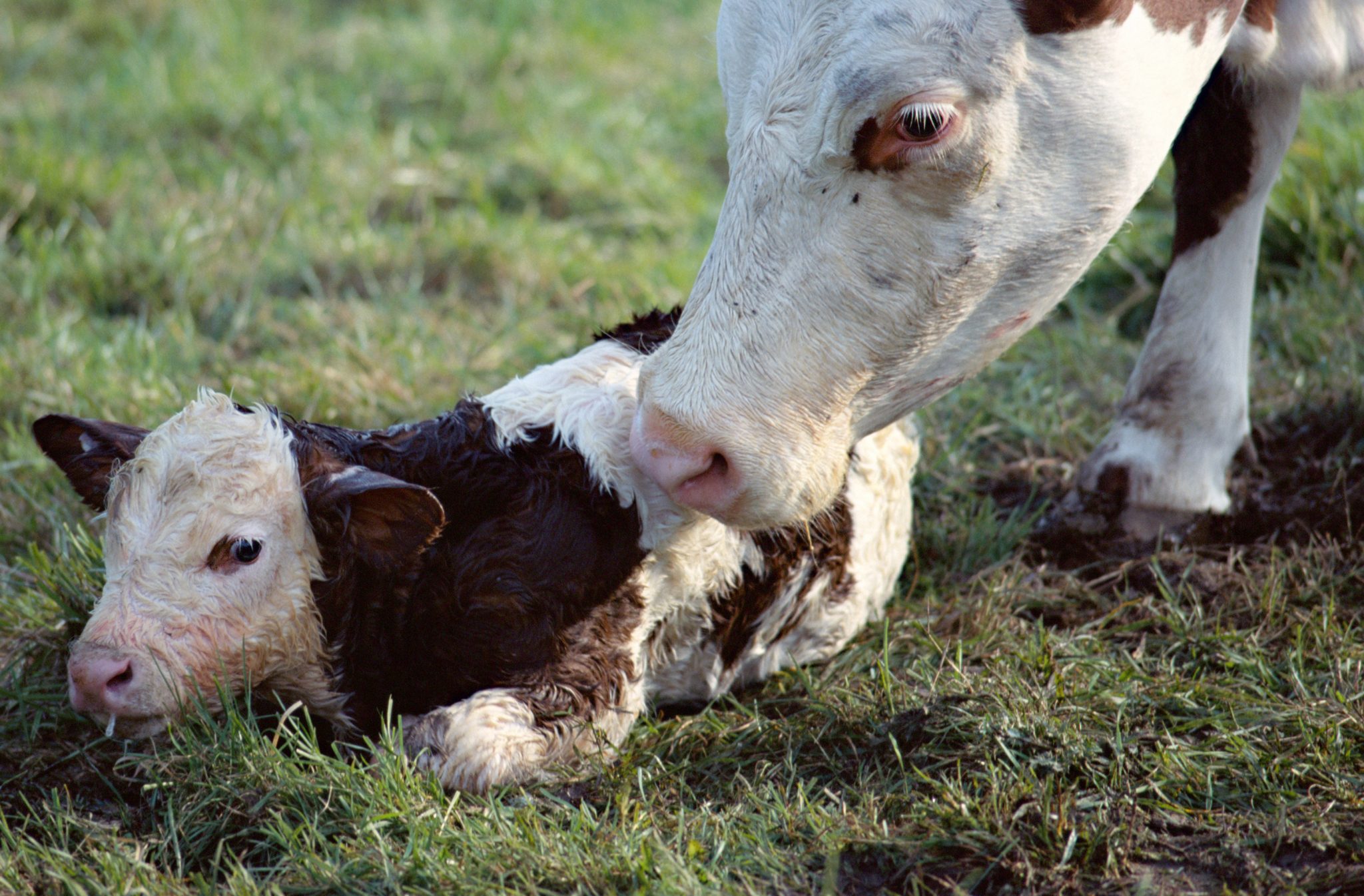Beef

A successful calving season is the result of good planning and hard work. A defined calving season, or one restricted to a certain period of time, begins with a defined breeding season, allowing you to concentrate your efforts on successful calving management. Before the calving season begins, identify the areas where you plan to calve, make a list of the cows and heifers expected to calve, and procure all the supplies required for calving. Check fences and corrals to ensure that they are suitable for cows, heifers, and calves, and develop an emergency plan for family members and employees to follow.
Supplies you need for calf delivery are as follows:
- Obstetrical (OB) chains for pulling on the calf’s legs (fig. 1). OB chains are preferred over other devices designed for the same use because they can be easily disinfected after each use and they do not damage the hide.
- OB handles for pulling on the OB chains.
- Mechanical calf puller (calf-jack) that can exert substantial force on the cow or heifer and the calf. Use caution. If used improperly, the cow, heifer, and/ or calf can be injured or killed.
- OB lubricants.
- Plastic gloves.
- Water buckets for cleaning and disinfecting.
- Towels and paper towels.
- Iodine or another appropriate disinfectant/drying agent for the calf’s navel.

Observation of cows and heifers before, during, and after the calving season is necessary to ensure the health and safety of cows, heifers, and calves. Cows should be checked at least once daily during the calving season, and heifers should be checked two to three times daily. Having the cows and heifers in an easily accessible pasture with access to working facilities will make this task more manageable. Also, allowing animals to calve in cleaner pastures away from accumulated mud and manure is better for the health of the calf and the cow or heifer.
One of the complications encountered during calving is dystocia, which means a difficult delivery. Because assistance is often required with a dystocia, you need to be familiar with the signs of impending calving as well as the sequence of events associated with normal labor and delivery to determine when or if assistance is needed.
Signs of impending calving are as follows:
- The udder and vulva may enlarge 1 to 3 weeks before calving.
- Cows and heifers may become more nervous (restless) and, if possible, may isolate themselves from the rest of the herd just before calving. They may also glance to the rear nervously.
- A cow or heifer may show signs of abdominal discomfort by kicking at her belly.
- The tail-head appears raised as ligaments around the rump of the cow or heifer relax.
Calving Stages
 Normal calving is divided into three stages: preparatory (dilation of the cervix), delivery of the calf, and expulsion of the placenta.
Normal calving is divided into three stages: preparatory (dilation of the cervix), delivery of the calf, and expulsion of the placenta.
As the preparatory stage begins, the cow or heifer may become nervous and isolate herself from the rest of the herd. She may also have a decrease in appetite and be found lying down but not chewing her cud. During this stage, uterine contractions begin, the colostrum (first milk) drops into the teats, and the fluid-filled placental membranes (water sac) containing the calf appear in the cervix. The preparatory stage typically lasts 4 to 8 hours for cows and 6 to 12 hours for heifers. When the water sac breaks, the next stage begins.
During the delivery stage, the cow or heifer begins actively straining. In normal parturition, the calf’s forelegs and head protrude first about 70 percent of the time, and the hind legs and tail come first about 30 percent of the time. This stage typically lasts less than an hour for cows and 1 to 2 hours for heifers. It is over when the calf is fully delivered.
In the final or expulsion stage, the straining decreases, but the uterine contractions continue in order for the placenta to be expelled. This stage may last up to 12 hours but should occur within the first few hours after delivery of the calf. If the placenta is not expelled soon after birth, do NOT manually remove the placenta by pulling it out. Contact your veterinarian. For more information about retained placenta and other complications that may occur during calving, refer to Extension publication ANR-1404, “Complications Associated with Calving.”
If parturition does not proceed as described, you may need to assist the cow or heifer with the birth or even seek assistance from a veterinarian or experienced cattle producer. Early intervention is the key to a successful outcome. Waiting too long unnecessarily risks the life of the cow or heifer and her calf.
- Calving takes time, and it often takes longer for heifers than for cows, so be patient. Progress should be steady and generally fit within the time frames mentioned. In other words, once the water sac (placental membrane) is seen protruding from the vulvar lips, a cow should deliver her calf within less than 60 minutes, and a heifer should deliver her calf within 90 minutes or less. Once the delivery stage begins, a cow or heifer should make visible progress about every 15 to 20 minutes.
- Use the 2+1 rule to help determine when to call for help. Upon examination, 2 feet and 1 head (or 2 feet and 1 tail) should be felt or seen for a normal delivery to proceed. If adequate time has elapsed and 2+1 is still not seen or felt, call for assistance.
- If the cow or heifer becomes exhausted and quits trying to calve, assistance is necessary.
- When in doubt, call your veterinarian. The outcome is always more favorable if assistance is provided sooner rather than later.
- No more than two strong people should pull on a calf at the same time. When pulling on a calf to assist with a delivery, try to pull only when the cow or heifer is actively contracting. This will facilitate progress and minimize the risk of uterine prolapse.
If possible, and if safe for you and the animal, corral the cow or heifer needing assistance before your veterinarian arrives. This will make the veterinarian’s job easier and minimize your expenses.
Other things to keep in mind when providing assistance are as follows:
- Never attach an OB chain or a rope to the calf’s jaw, because the jaw will almost always fracture.
- Be careful not to apply excessive force when using a calf-jack.
- Never attempt to deliver a calf by pulling it with any type of vehicle.
Providing Assistance During Calving
The first step in providing assistance during calving (parturition) is assessing the problem. Several common situations encountered when delivering a calf are described below and illustrated in the accompanying images.
- Normal Delivery
- Calf Too Big
- Breech (Hindquarters First with Both Hind Legs Retained)
- Head Turned to the Side
- Retained Foreleg(s)
- Head Underneath Both Forelegs
Download a PDF of Managing a Successful Calving Season, ANR-1403.

